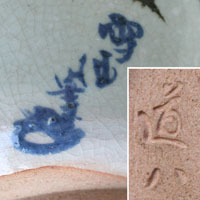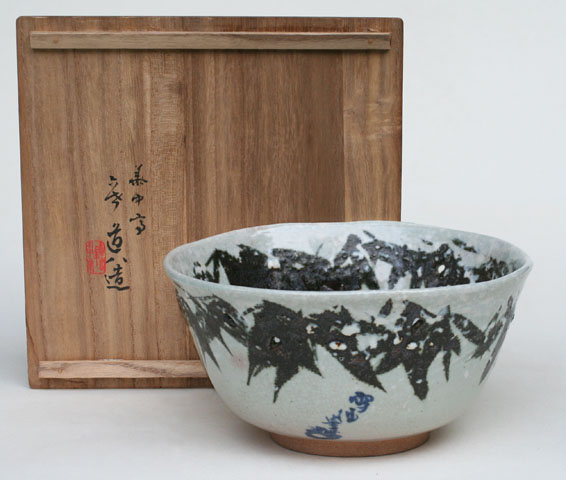Kyôyaki
Kashibachi, fruit bowl - Setsuchiku, Snow and bambooSigned: Sekka hitsu with kaô
Seals: Dôhachi
Technique: grey crackled go-gaku shaped* kyôyaki, with a tetsu-e, iron oxide, underglaze design of bamboo, covered with ‘snow flakes” from slip and perforations to outline bamboo leafs. Ø 19 x 9,5
Date: 1920s
Box: signed by Dôhachi
Condition: fine
*go-gaku shape, the peaks of the five sacred mountains (Takachiho, Kongôzan, Nioizan, Hieizan and Atagoyama)
Sekka was one of the leading designers of Meiji, Taishô and early Shôwa periods in Kyoto.
Sekka was both a late master of the Rimpa style and a pioneer of modern design in Japan. Born in Kyoto he had begun his artistic studies at the age of sixteen. In 1901 he went on a trip to Europe (notably Glasgow). Exposure to the European tradition of industrial design caused his own sense of design to blossom. His knowledge of Rimpa painting and his explorations in the field of design went hand in hand. He worked at the prestigious Kyoto City Municipal Museum and at the Kyoto Municipal School of Fine Arts and Crafts. He exhibited at, and was judge for, the Kyoto Art Association, the San Francisco Great Exhibition, and the regular Domestic Industrial Design exhibitions. He received numerous imperial commissions and was decorated several times by the Japanese and French governments for his work. He is considered the father of modern design in Japan.
Reference:
Kyoto 2003
Takahashi Dôhachi VI was born in Kyoto as the second son of Dôhachi IV (1845-1897). He studied with his father as well and his brother Dôhachi V (1869-1914) but also studied at the Kyoto Municipal Ceramics Laboratory. He inherited the title after his brother died in 1915 and he became Dôhachi VI in 1915. Dôhachi VI was known for his blue white porcelain and sencha ware.
Reference:
Kyoto 2003 p. 327
Price: ON REQUEST

